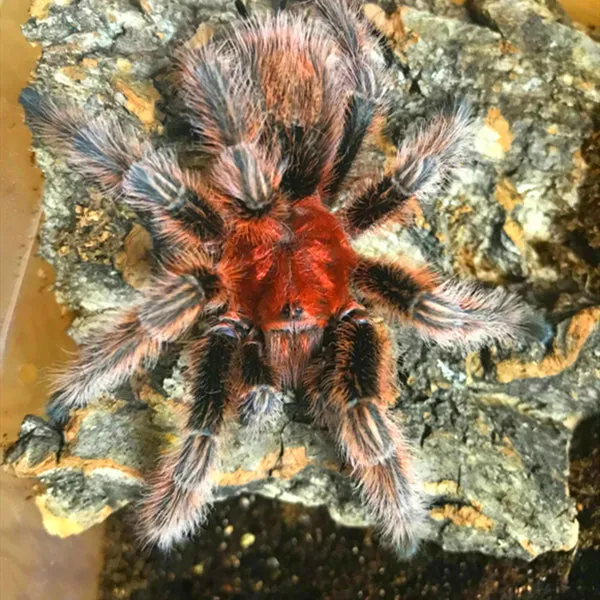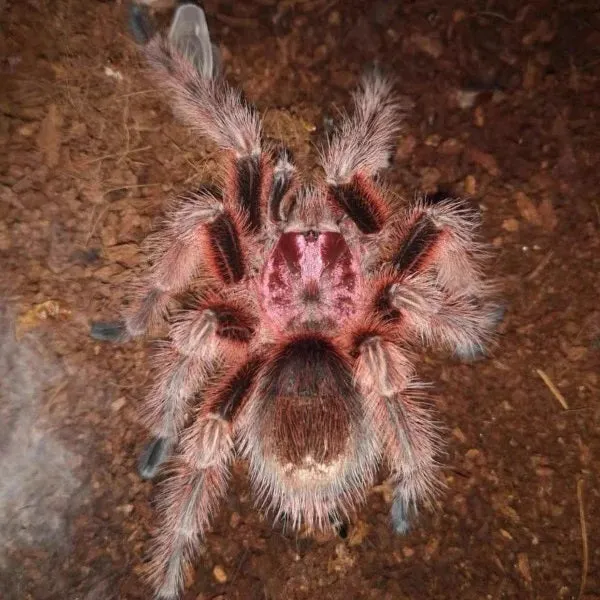What is a Chilean Rose Tarantula?
The Chilean Rose Tarantula (Grammostola rosea) is a popular choice among beginner tarantula keepers due to its docile nature and relatively low maintenance requirements. Native to the grasslands of Chile, Bolivia, and Argentina, these arachnids are known for their beautiful, albeit subtle, coloration and manageable size. Before delving into the cost, understanding what makes this species so appealing is crucial. They are ground-dwelling tarantulas and thrive in a terrestrial environment, making their care easier compared to arboreal species. Their lifespan, typically ranging from 7 to 10 years for females, adds to their appeal as a long-term pet. Considering their popularity, learning about the cost to get one will help you decide if it is the right pet for you.
Physical Characteristics of Chilean Rose Tarantulas
Knowing what a Chilean Rose Tarantula looks like is important for identifying them and understanding what to expect. These spiders have a distinctive appearance, which is a factor in their desirability as pets. Their size and lifespan are also important factors for potential owners.
Appearance

Chilean Rose Tarantulas typically display a brown or rose-colored body, with a carapace that can range from bronze to tan. The legs often have a pinkish hue, hence the name ‘rose’. Their coloration can vary based on individual genetics and environmental conditions. They have a hairy appearance, typical of tarantula species, which aids in their sensory perception and defense mechanisms. The chelicerae, or mouthparts, are strong and used for feeding, and they possess spinnerets at the end of their abdomen for silk production, which they use for creating webs and molting mats. The overall appearance makes them a captivating pet.
Size and Lifespan
Adult Chilean Rose Tarantulas typically reach a leg span of 4 to 6 inches, making them a manageable size for most pet owners. Females tend to be larger than males and can live for 7 to 10 years, while males often have a shorter lifespan, typically 2 to 3 years after reaching maturity. This lifespan is an important factor when considering the long-term commitment and associated costs of owning one of these spiders. The size allows them to be housed in relatively small enclosures compared to larger tarantula species. The lifespan means the owners will have a long-term companion.
Factors Influencing Chilean Rose Tarantula Cost
The price of a Chilean Rose Tarantula isn’t a fixed number; several factors can influence how much you’ll pay. Understanding these variables will help you budget effectively and make informed decisions when purchasing your tarantula.
Tarantula Age and Size

Spiderlings (young tarantulas) are generally less expensive than older, more established specimens. This is because they are smaller, require less space, and have a shorter lifespan ahead of them. As the tarantula grows, its value may increase due to its size and the time invested in its care. However, the price difference is often not significant, as the cost of the tarantula itself is only a fraction of the total cost of ownership. Juveniles offer a good balance between cost and the ability to observe their growth and behavior. Larger specimens, especially mature females, may command a higher price due to their size and potential for longer lifespans.
Spider’s Origins and Breeder Reputation
The origin of the tarantula and the reputation of the breeder can significantly impact the price. Tarantulas bred by reputable breeders who prioritize the health and genetics of their spiders may be more expensive. These breeders often provide detailed information about the tarantula’s lineage, health, and any special care requirements. Captive-bred tarantulas are generally preferred over wild-caught ones, as they are typically healthier and less stressed. The geographic location of the breeder and the cost of their operation can also influence the price. Always research breeders to ensure they have a good reputation.
Morphs and Color Variations
While Chilean Rose Tarantulas typically have the same coloration, some slight variations may exist due to genetic factors. However, the price differences between these variations are typically minor. If you come across a tarantula with a particularly striking color, it might be priced slightly higher, but this is not a common practice. The primary cost drivers are usually related to the tarantula’s age, size, and the breeder’s reputation. More unusual or rare tarantula species, on the other hand, can have dramatically higher prices due to their scarcity.
Where to Buy a Chilean Rose Tarantula

Finding a reputable source to purchase your Chilean Rose Tarantula is essential for ensuring you get a healthy spider. Several options are available, each with its own advantages and disadvantages.
Local Pet Stores
Local pet stores can be a convenient option, allowing you to see the tarantula in person before purchasing. However, the selection may be limited, and the staff may not always have specialized knowledge about tarantula care. Prices can sometimes be higher compared to other sources. Before buying, inspect the tarantula carefully for any signs of illness or injury. Inquire about the spider’s origin and care history. Make sure the store follows proper housing guidelines for the tarantula. Ask if the pet store offers any guarantees or return policies. This will minimize any problems if the spider turns out to be sick or injured. Ensure that the staff is knowledgeable.
Specialized Breeders
Specialized breeders often provide the healthiest tarantulas with detailed care information. They typically have extensive knowledge and can answer your questions. The price may be slightly higher, but you’re often paying for the assurance of a healthy spider and expert advice. Research breeders online, check reviews, and ask for references. Breeders will usually have a better understanding of their spider’s lineage and any special care requirements. This can be particularly helpful for beginners. Breeders can also provide advice.
Online Retailers

Online retailers offer a vast selection and competitive prices. However, it’s crucial to research the retailer’s reputation and read reviews before making a purchase. Ensure the retailer provides detailed information about the tarantula’s care and health. Check their shipping policies and guarantees. Confirm they use proper packaging to ensure the tarantula arrives safely. Look for retailers who specialize in live animal shipping to minimize any risks. Buying online gives you access to more options and often better prices. Online retailers can also offer payment plans, which can help if you are on a budget. Always prioritize retailers who prioritize the welfare of the animals.
Ongoing Costs of Chilean Rose Tarantula Ownership
Beyond the initial purchase price, several ongoing costs are associated with owning a Chilean Rose Tarantula. Understanding these costs is crucial for budgeting and ensuring you can provide the necessary care throughout the spider’s lifespan.
Enclosure and Setup Expenses
The initial setup costs include the enclosure itself, substrate, and décor. A suitable enclosure for a Chilean Rose Tarantula should be appropriately sized, well-ventilated, and secure. The substrate should be appropriate for burrowing, such as coco fiber or a mix of peat moss and vermiculite. Décor can include a water dish, hiding places (e.g., cork bark), and possibly some artificial plants. The cost of the enclosure can range from $20 to $50 or more, depending on the size and material. Substrate and décor will need to be replaced periodically. Budgeting for the ongoing cost of substrate and replacing any worn or damaged items is necessary. The initial investment in setup is a one-time cost, but the ongoing maintenance will add to the yearly expense.
Feeding and Substrate Costs

Chilean Rose Tarantulas eat primarily insects, such as crickets, mealworms, and roaches. The cost of these insects will vary depending on the source and quantity purchased. Buying insects in bulk can often reduce the cost. In addition to food, the substrate needs to be replaced periodically to maintain a clean and healthy environment. The frequency of substrate replacement depends on the size of the enclosure and how quickly it becomes soiled. The cost of these supplies will fluctuate, so budgeting for these recurring expenses is important. Feeding frequency will vary with the tarantula’s age. Younger tarantulas need to be fed more often than adults. Consider these factors when estimating your monthly costs.
Veterinary Care and Health
While Chilean Rose Tarantulas are relatively hardy, veterinary care may be needed if your tarantula becomes ill or injured. Finding a vet experienced in treating arachnids can be challenging and expensive. It is highly unlikely the spider will need vet care. Preventative measures, such as maintaining a clean enclosure and providing proper humidity, can minimize health risks. Researching local vets specializing in exotic pets is advisable. Budgeting a small amount each year for potential vet visits can ensure you can provide the necessary care if needed. The cost of vet care will vary depending on the services needed.
Comparing Chilean Rose Tarantula Costs
Comparing the costs associated with owning a Chilean Rose Tarantula to other pets helps determine whether it fits your budget and lifestyle. Consider these comparisons when making your decision.
Cost vs. Other Pet Tarantulas
Chilean Rose Tarantulas are generally among the most affordable tarantula species. Their relatively low maintenance requirements and common availability contribute to their lower cost. Compared to more exotic or rare tarantula species, the initial purchase price is significantly less. The ongoing costs are also relatively low, primarily consisting of food and substrate. This makes them an excellent choice for beginners. Some other tarantula species, such as the G. pulchra, or the Brazilian Black, may be more expensive. These species are rare or in high demand. When comparing costs, consider the lifespan. Chilean Rose Tarantulas have a long lifespan, so the costs will be spread out over several years. This will lower the average annual cost.
Long-Term Cost Benefits of Owning a Chilean Rose Tarantula
The long lifespan of Chilean Rose Tarantulas provides long-term cost benefits. While the initial purchase price and setup costs are relatively low, the ongoing costs are also manageable. They do not require expensive vet visits, specialized diets, or extensive housing. This makes them a cost-effective pet for those seeking a low-maintenance companion. The lifespan of the tarantula offers years of enjoyment. The low initial investment compared to other pets, such as dogs and cats, makes them more accessible. You can avoid the recurring costs of things like grooming, toys, and professional walking services. Their simple care requirements and long lifespan make them a cost-effective choice.
Tips for Saving Money on Your Tarantula
While the cost of owning a Chilean Rose Tarantula is already relatively low, several strategies can help you save money.
Buying in Bulk
Purchasing substrate and food in bulk can significantly reduce the cost. Many online retailers and pet stores offer discounts for buying larger quantities of supplies. This can lead to substantial savings over time, especially on items that you will need to replace regularly. When buying in bulk, ensure you have adequate storage space to keep the supplies fresh and prevent spoilage. This is especially important for food items, such as live insects. Bulk buying will allow you to get the best price.
DIY Enclosure Options
Instead of purchasing a pre-made enclosure, you can create your own. This can be a cost-effective way to save money. Ensure that the enclosure is well-ventilated, escape-proof, and made from non-toxic materials. Using readily available materials, such as plastic storage containers or repurposed glass tanks, can help you reduce the initial setup costs. You can add your own flair to the enclosure and customize it to your preferences. DIY enclosure options let you control the overall cost, which can save you money.
In conclusion, the cost of a Chilean Rose Tarantula is relatively low, making it an accessible and rewarding pet for many. The initial purchase price is affordable, and the ongoing costs are manageable, especially compared to other pets. By considering the factors influencing the price, choosing reputable sources, and implementing cost-saving strategies, you can enjoy the unique experience of owning a Chilean Rose Tarantula without breaking the bank. Properly preparing and budgeting ensures a positive experience.
